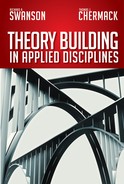PART TWO
Phases of Theory Building
4 Conceptualize Phase
5 Operationalize Phase
6 Confirm Phase
7 Apply Phase
8 Refine Phase
IF YOU EXAMINE the existing approaches to theory building, you will easily conclude that they are incomplete, inappropriate, or overwhelming. This is because they are based on methodological biases, are couched within specific applied disciplines, or present a level of detail that can only be described as tedious—thus making their utility difficult. All of these conditions add to missing the mark for developing sound theory in applied disciplines.
The foundations of theory building and the method for theory building in applied disciplines have been described in the preceding three chapters of Part One. Now Part Two dives deep into each of the theory-building phases: Conceptualize, Operationalize, Confirm, Apply, and Refine.
A key goal for this book is to present a theory-building method that is complete and that works—including phases, steps, tools, and techniques. The activities, outputs, and quality indicators for each phase are described. Each of the five phases serves as a chapter organizer.
Chapter 4, the “Conceptualize Phase,” covers the material related to new ideas, concepts, and sets of ideas that may become theories. Four documented approaches are summarized as well as a variety of tools the theorist might use. The Conceptualize phase for building theory in applied disciplines is presented as an integrative framework for working through the conceptual demands of theory building. Any theorist, novice or expert, can grab this chapter and use its ideas to initiate a theory-building effort.
Chapter 5, the “Operationalize Phase,” focuses on how sets of concepts get translated to assessment criteria. In other words, this phase demands that the theorist identify measurement criteria for a possible theory and describe how the accuracy and adequacy of the theory will be judged. We discuss the Operationalize phase with the intention of demystifying how operationalization works. We also clarify how research paradigms other than the scientific method can fulfill the operationalize concept.
Chapter 6, the “Confirm Phase,” deals with investigating theories through research. We use the term inquiry studies to denote that instances of research usually accumulate in the context of theory building, and their collective statements are assembled through judgment. While there are many sources for the conduct of research, several put research in the larger context of theory building. Tips and requirements are structured in this phase of building theory in applied disciplines.
Chapter 7, the “Apply Phase,” ensures the connection of theory to practice. Theories must lead to changes and developments in practice so that it is more effective or efficient. Conversely, practices must lead to changes and developments in theory so that it is more effective or efficient. Few theorists go so far as to describe practical procedures based on their theoretical work. This critical activity in the Apply phase is a key point for advancing applied disciplines.
Chapter 8, the “Refine Phase,” discusses the complex and ongoing nature of theory building. Applied discipline theories are never really totally complete. They must constantly be assessed amid the changing environment of practice. In addition, developments may require the theorist to consider new concepts, alternative ways of operationalizing a theory, other research paradigms, and novel practice. At its essence, the Refine phase may mandate revisiting one or all of the phases of theory building.
Taken as a whole, the five phases of Theory Building in Applied Disciplines ensures that theories come from a comprehensive perspective with a required connection to practice. The method is not based in a particular discipline or research paradigm, and we have worked hard to make the techniques, tools, and frameworks accessible. They should be used. Part Two provides the knowledge you need to start your theory-building work.
